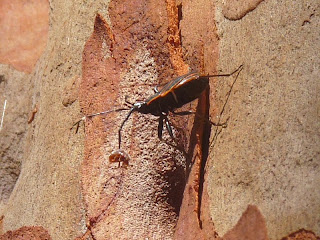I'm not sure which is the greater sucker; butterflies, or me where they're concerned.
We're well aware of the ability of most moths and butterflies to extract nectar from a flower's nectary gland, and thus perform a crucial pollinating role for many flowering plants. However it's not so easy usually to see how they manage it. The trick is the possession of a proboscis, rather like a flexible coiled drinking straw with a sensory apparatus at the end. Here are a couple.
 |
| Owl Butterfly, Amazonian Ecuador. The proboscis is just visible, tightly coiled in front of its head. |
 |
| Yellow Admiral, Vanessa itea, National Botanic Gardens Canberra. Here the proboscis is more visible, partly uncoiled. |
The proboscis comprises two trough-like structures called galeae; in other insects, and presumably the ancestral butterfly, they are small cup-like structures attached to the floor of the mouth. By a remarkable process, the two galeae begin extending and coiling as soon as the adult emerges from the pupa, aligning themselves to form a single tube. When this happens a temporary liquid glue holds them in place until fringing structures zip them permanently together. Inside is fibrous material like blotting paper; liquid is drawn up by a mixture of passive capillary action, and active muscular pumping, using a 'bellows' in the butterfly's head. When required the proboscis unfurls and can be very delicately applied. Both the following images feature male Australian Painted Ladies (yes, I know that's an oxymoron!) Vanessa kershawi at the National Botanic Gardens. The top one is on an Isotoma, the lower one on a Xerochrysum paper daisy.
Butterflies as a group evolved at least 190 million years ago, but the proboscis seems not to have appeared until somewhere between 100-145 million years ago. The implication is strongly that it coincided with the development and dramatic spread of flowering plants. On the other hand it could as validly be proposed that the butterfly proboscis developed to take up dew or sap, and the subsequent adaptation to nectar actually assisted the dominance of flowering plants; either way both have flourished together.
Either way too, a familiar pattern has emerged, of a structure arising for one purpose and later becoming harnessed for other purposes. Butterflies regularly use this wonderful structure for taking up other liquids - from protein of dead animals, to soft fruit to water from mud.
 |
| drinking from wet sand, Manu River, Amazonian Peru; both above photos |
 |
| drinking from mud, Budongo Forest, Uganda |
 |
| Butterflies (and flies) on Civet droppings, Budongo Forest |
Finally I should acknowledge that other insect groups have proboscises for much the same reason, but they developed quite separately, from different mouth parts. True bugs (ie Hemipterans, not the catch-all way we sometimes use 'bug' to refer to any creepy-crawly animal) have one formed from the chewing mouth parts - the maxillae and mandibles - extended into a piercing structure and sheathed by the labium, the floor of the mouth. This can be used for piercing either plant tissue or animals.
 |
| Sap-sucking bug, Kata Tjuta |
 |
| Assassin Bug (very small!) with prey (even smaller!!), Jervis Bay |
 |
| unidentified fly on Xerochrysum paper daisy, National Botanic Gardens |
 |
| March Fly (Tabanid) about to pierce my trouser leg, etc... |
As ever, I could easily go on digressing, but that's enough to go on with; I'll leave to poke your own proboscis into it as it suits you.




2 comments:
Nice post, Ian, with many stunning (and unfamiliar insects) Unfamiliar to me, anyway.
Great shot of the Assassin Bug with its prey skewered.
They are insects with attitude.
Thanks for the technical explanation of the structure of the proboscis.
Thanks for those kind words Denis; I'm glad you enjoyed it, as I had fun researching it. I know you're better informed on insects than I am.
Post a Comment